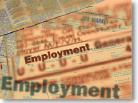|
Job growth sputters in May
|
 |
June 4, 1999: 8:30 p.m. ET
Economy adds only 11,000 new jobs, below forecasts; jobless rate at 4.2%
By Staff Writer M. Corey Goldman
|
NEW YORK (CNNfn) - Job growth slowed dramatically in May but workers' wages grew at a surprisingly brisk pace, the U.S. government said Friday -- providing mixed signals about the economy and whether there's any need for the Federal Reserve to raise interest rates to ward off inflation.
The economy created 11,000 jobs outside the farm sector, the Labor Department said, well below the 216,000 average increase forecast by analysts, according to Reuters.
The rise in May payrolls was significantly less than the revised gain of 343,000 in April; the Labor Department initially reported an increase of 234,000 jobs for April.
The jobless rate fell to 4.2 percent, matching a 29-year low, from 4.3 percent in April. The Reuters consensus had forecast a rate that was unchanged.
"Today, we have more good news about continuing prosperity in our economy," President Clinton said in a statement after the jobs report.
"Combined with the continued strong overall economic growth, low long-term inflation and continued rising wages, we are widening the circle of opportunity for more Americans."
Average hourly earnings, a measure of inflation, rose 5 cents an hour, or 0.4 percent, to $13.19. That follows a revised increase of 0.2 percent in April and was above the Reuters consensus of a 0.3 percent rise.
The widely anticipated report was supposed to provide analysts and economists with a clear perspective on the direction of U.S. interest rates. Evidence of strong job growth was expected to make it more likely that policy makers at the Fed, the nation's central bank, would raise interest rates at their meeting later this month.
But that's not the signal it gave. Rather, the numbers provided a mixed picture of the impact that job growth and wages have on the U.S. economy, analysts and economists said.
"The report was very confusing," said Jeff Cheah, an analyst with Standard & Poor's MMS in Toronto. "The general consensus feeling is that no one knows what, if anything the Fed is going to do."
Talkin' about market gyrations
The confusion was evident in both the stock and bond markets.
The U.S. 30-year bond fell in value -- and its yield surged to near 6 percent -- immediately following the report's release as investors focused on the average hourly wages number and the massive upward revision in April's job growth.
Within minutes, however, they settled back down as investors concluded the slowdown in job creation may be enough to keep inflation at bay. Shortly before 3 p.m. ET, the benchmark 30-year Treasury bond slipped 5/32 of a point in price to 90-2/32, pushing the yield up to 5.96 percent.
By the end of trading, the stock market had reacted positively. The Dow Jones industrial average rose 136.15 points, or 1.3 percent, to close at 10,799.84 in Friday's session.

Employers hired fewer new workers in May
"I really don't think we can make too much out of one month's report," Alexis Herman, U.S. Secretary of Labor, told CNNfn. "I don't think it's enough for us to predict where the economy is headed right now."
The Fed's policy-making committee meets June 29-30 to discuss the direction of the economy and possible interest rate action. At its last meeting May 18, central bankers shifted to a bias favoring higher rates, though they've emphasized that doesn't mean they have to act to raise rates.
The last time the monthly non-farm job production rate was this low was January 1996, when some 7,000 jobs were eliminated. For the past 12 months, the U.S. jobless rate has been at or below 4.5 percent.
'Next, please'
Jobs in the service sector increased at a far slower pace, climbing 103,000 in May compared with 339,000 in April. And factory employment continued weak, with 45,000 jobs cut in May - an increase from 28,000 in April. Since March 1998, factories have cut 453,000 jobs.
Average weekly hours worked rose to 34.5 in May from 34.4 during April, while manufacturing overtime increased to 4.6 hours in May from 4.3 hours during April.
The index of hours worked, which combines changes in the work week with changes in payroll growth, rose to 147.3 in May from 147.0 during April. And average weekly earnings increased to $455.06 in May
from $452.02 during April.
The percentage of unemployed workers who voluntarily quit their jobs in May fell to 13.4 percent from 13.9 percent in April. The percentage of the U.S. population holding jobs was unchanged at 64.2 percent in May.
For the year so far, the economy has added 981,000 jobs. For all of 1998, the economy added 2.9 million jobs, down from 3.4
million in 1997.
Now looking ahead
"The inflation report and Greenspan's testimony are now going to be the primary focus of financial markets," Cheah said. "It will be the main indicator for where rates will go."
The Labor Department will release May's consumer price index report, or CPI on June 17. The consensus of analysts surveyed by MMS, the Standard & Poor's research arm, forecast that prices on store shelves rose 0.1 percent in May after jumping 0.7 percent in April. The core rate, which excludes often-volatile food and energy costs, rose 0.2 percent, according to the MMS survey.
The following day, June 18, Fed Chairman Alan Greenspan is slated to give his semi-annual Humphrey-Hawkins testimony to U.S. Congress. Greenspan's public reflections on the economy sometimes give market participants helpful hints on where the Fed may take interest rates. 
|
|
|
|
|
|
Labor Department
|
Note: Pages will open in a new browser window
External sites are not endorsed by CNNmoney
|
|
|
|
 |

|

